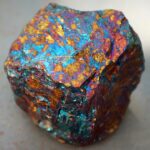Silicon, a versatile element with unique properties, plays a pivotal role in the world of technology. It is a metalloid, sharing characteristics of both metals and nonmetals. Among its many applications, silicon’s use in computer chips stands out as one of the most critical and transformative. This article will delve into the intriguing world of silicon, exploring its properties, its role in computer chips, and its impact on modern electronics. By the end of this comprehensive guide, you will have a deeper understanding of why silicon is the metalloid of choice for computer chips.

-
Properties of Silicon
Silicon is a chemical element with the symbol Si and atomic number 14. Its properties make it a fascinating and versatile element. Let’s examine some of the key characteristics that set silicon apart:
1.1. Semiconducting Nature
Silicon is classified as a metalloid due to its unique electrical properties. It acts as a semiconductor, a property that makes it highly desirable for use in electronic devices. Unlike metals, which conduct electricity well, and nonmetals, which are poor conductors, silicon falls somewhere in between. Its semiconducting behavior allows for precise control of electrical currents, making it ideal for applications where such control is essential, like computer chips.
1.2. Abundance in Nature
One of the reasons silicon is a popular choice for computer chips is its abundance in the Earth’s crust. It ranks as the second most abundant element, comprising approximately 28% of the Earth’s crust by weight. This abundance ensures a stable supply of raw materials for the electronics industry.
1.3. Strong Covalent Bonds
Silicon is known for forming strong covalent bonds with other silicon atoms, creating a crystalline lattice structure. This unique structure contributes to its mechanical and thermal stability, essential qualities for computer chip materials.
1.4. High Melting and Boiling Points
Silicon’s high melting point (1414°C) and boiling point (3265°C) make it an excellent choice for electronic components, which often operate at high temperatures. Its ability to maintain its structural integrity at elevated temperatures is crucial in preventing chip failure.
-
The Role of Silicon in Computer Chips
Computer chips, also known as integrated circuits, are the brains behind modern computing. These tiny devices perform complex calculations and store vast amounts of data. The integration of silicon into these chips is not a coincidence but rather a well-considered choice based on its unique properties.
2.1. Semiconductor Transistors
At the heart of every computer chip lies the semiconductor transistor. Transistors are the building blocks of digital logic, allowing for the amplification and switching of electronic signals. Silicon’s semiconducting nature, which falls between metals and nonmetals, is essential for transistor operation. By applying voltage to the silicon material, transistors can be turned on and off, facilitating the binary operations fundamental to computing.
2.2. Miniaturization and Moore’s Law
Silicon’s ability to be precisely manufactured into incredibly small structures has been crucial for the development of increasingly powerful computer chips. Gordon Moore, co-founder of Intel, observed in 1965 that the number of transistors on a computer chip doubled approximately every two years. This observation, known as Moore’s Law, has held true for decades, driving the rapid evolution of technology. Silicon’s role as the primary material for semiconductors has been pivotal in sustaining Moore’s Law.
2.3. Silicon Wafers and Photolithography
Silicon is not used in its elemental form but rather in the form of silicon wafers. These wafers serve as the substrate for fabricating integrated circuits. During the manufacturing process, photolithography is used to create intricate patterns on the silicon wafer. These patterns define the locations of transistors and other circuit elements, allowing for precise control over the electrical behavior of the chip.
2.4. Integration of Other Materials
While silicon is the foundation of computer chips, it is not the only material used. Modern chips often incorporate other elements and materials, such as metal interconnects and dielectric materials, to improve performance and energy efficiency. The combination of various materials on a silicon substrate results in complex integrated circuits capable of executing diverse functions.
-
Evolution of Silicon-Based Computer Chips
The evolution of silicon-based computer chips has been nothing short of remarkable. Over the decades, these chips have become smaller, more powerful, and more energy-efficient. This section explores the key milestones in the development of silicon chips.
3.1. Early Days: Discrete Components
In the early days of computing, individual transistors and other electronic components were assembled into circuits manually. This approach was labor-intensive, resulting in bulky and power-hungry computers. The introduction of silicon transistors marked a significant advancement in electronics, enabling smaller and more efficient devices.
3.2. First Integrated Circuits
The 1960s saw the emergence of the first integrated circuits, where multiple transistors and components were fabricated on a single silicon substrate. These early chips were relatively simple, containing only a few transistors. However, this breakthrough paved the way for the development of more complex and powerful chips in the future.
3.3. Microprocessors and Personal Computers
The 1970s witnessed the birth of the microprocessor, a specialized integrated circuit that served as the central processing unit (CPU) in early personal computers. The Intel 4004, introduced in 1971, is considered one of the first microprocessors and played a pivotal role in the personal computing revolution.
3.4. Advancements in Manufacturing
Advancements in semiconductor manufacturing processes, including photolithography and clean-room technologies, have allowed for the mass production of increasingly complex and miniaturized chips. The ability to create smaller transistors and tightly packed circuits has led to the development of more powerful computers, smartphones, and other electronic devices.
3.5. Rise of Mobile and IoT Devices
The 21st century has seen the rise of mobile devices and the Internet of Things (IoT). Silicon-based chips have become essential components in smartphones, tablets, wearables, and IoT devices. These chips are not only smaller but also highly energy-efficient, making them suitable for battery-powered applications.
3.6. Quantum Computing and the Future
Looking ahead, silicon-based computer chips continue to evolve. Researchers are exploring new materials and techniques to overcome the limitations imposed by Moore’s Law, as transistors approach atomic scales. Quantum computing, which relies on the unique properties of quantum bits (qubits), holds promise for solving complex problems that are beyond the reach of classical computers.
-
Silicon and the Electronics Industry
Silicon’s significance extends beyond computer chips; it is a foundational element in the broader electronics industry. Here are some of the ways silicon plays a crucial role in electronics:
4.1. Solar Cells
Silicon is widely used in photovoltaic cells, commonly known as solar panels. Solar cells harness the energy from sunlight and convert it into electricity. The semiconducting properties of silicon are essential for capturing and conducting the generated electricity.
4.2. Transistors and Memory Devices
In addition to computer chips, silicon is used in a wide range of electronic components, including transistors, diodes, and memory devices. These components are essential for building electronic circuits found in everything from televisions and smartphones to household appliances.
4.3. LEDs and Displays
Light-emitting diodes (LEDs) and liquid crystal displays (LCDs) are integral parts of modern electronics. Silicon plays a role in the control circuits and drivers that operate these displays, ensuring vibrant visuals and energy efficiency.
4.4. Power Electronics
Silicon is also used in power electronics, which control the conversion and management of electrical energy. These components are crucial in applications such as electric vehicles, renewable energy systems, and industrial automation.
4.5. Sensors and Detectors
Sensors and detectors used in various applications, such as automotive safety systems and medical devices, often incorporate silicon components. These sensors rely on silicon’s ability to respond to changes in physical parameters, such as pressure, temperature, and light.
-
Environmental and Ethical Considerations
While silicon has undoubtedly revolutionized the electronics industry, it is not without its environmental and ethical challenges. Here are some of the key considerations:
5.1. Resource Extraction
The production of silicon wafers for computer chips involves resource-intensive processes, including mining, refining, and energy-intensive manufacturing. Responsible sourcing and recycling initiatives are becoming increasingly important to reduce the environmental impact of silicon production.
5.2. E-Waste
The rapid obsolescence of electronic devices leads to a significant amount of electronic waste (e-waste). Proper disposal and recycling of e-waste are crucial to mitigate environmental pollution and recover valuable materials like silicon.
5.3. Ethical Concerns
The electronics industry has faced scrutiny regarding ethical concerns related to labor practices, especially in the manufacturing of electronic components in some regions. Companies are increasingly under pressure to ensure fair and ethical working conditions in their supply chains.
5.4. Energy Efficiency
While silicon-based chips have become more energy-efficient, data centers that host large quantities of servers and storage devices consume substantial amounts of energy. Research into improving the energy efficiency of data centers and developing more sustainable computing practices is ongoing.
-
Beyond Silicon: Emerging Technologies
While silicon has been the primary material for computer chips and electronics for decades, researchers are exploring alternative materials and technologies to address the challenges posed by Moore’s Law and the quest for more powerful and energy-efficient computing. Some of these emerging technologies include:
6.1. Graphene
Graphene, a one-atom-thick sheet of carbon atoms, is a promising material for electronics. It has exceptional electrical conductivity and mechanical properties, making it a potential replacement for silicon in certain applications.
6.2. Quantum Computing
Quantum computing leverages the principles of quantum mechanics to perform computations that classical computers cannot. Quantum bits, or qubits, can exist in multiple states simultaneously, opening up new possibilities for solving complex problems.
6.3. Neuromorphic Computing
Neuromorphic computing draws inspiration from the human brain’s structure and function. It uses specialized hardware and algorithms to perform tasks such as pattern recognition and machine learning with high efficiency.
6.4. 2D Materials
Beyond graphene, other two-dimensional materials, like transition metal dichalcogenides, are being explored for their unique electronic properties. These materials have the potential to enable new types of electronic devices.
-
Conclusion
Silicon, a metalloid with a unique combination of properties, has been at the core of the electronics industry for decades. Its semiconducting nature, abundance, and stability make it the ideal choice for computer chips, integrated circuits, and a wide range of electronic components. As technology continues to advance, silicon-based chips have evolved to become smaller, more powerful, and more energy-efficient.
While silicon remains a key player in the electronics industry, the pursuit of even more advanced technologies, including quantum computing and novel materials like graphene, is ongoing. These emerging technologies promise to further transform the world of computing and electronics.
In the end, the answer to the question, “The metalloid that is used to make computer chips is?” is unequivocally silicon. Silicon’s remarkable properties and its ever-evolving role in the world of technology make it a cornerstone of modern electronics and computing.





